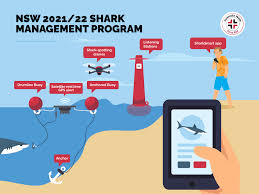Plenty of Fish
By Sean Doherty, Editor of Surfing World
Tuncurry has new locals
A bit of local folklore.
Back maybe 20 years, a local diver was exploring around Latitude Rock, just off Cape Hawke. He swam into an undersea cave and was confronted, to his great surprise, by a large great white shark. The creature was dead, somehow caught in there and drowned. Pub versions of this story in years ahead however had the shark sporting a bullet hole between the eyes. The shark was eventually towed back into town, where it was taken to the Tuncurry fish co-op. News of the shark quickly spread and the co-op was soon abuzz with curious locals, keen to get a look at the beast from the deep. Traffic backed up and the local coppers walked up and down the street handing out parking fines.
Pub versions of this story in years ahead
had the shark sporting a bullet hole between the eyes.
Just 20 years ago, a great white shark was a thing of great curiosity. In the twin north coast fishing towns of Forster-Tuncurry, few surfers or fishermen had ever seen one in the wild. They were more myth than reality. Surfers would paddle out half a mile and surf the fabled rights of Tuncurry Bar without a second thought of what else might be swimming around out there. Local fisho, Grunter would drive his boat past surfers out there, throwing fish guts overboard, laughing. “Gave ‘em something to think about!” he’d bellow, laughing.
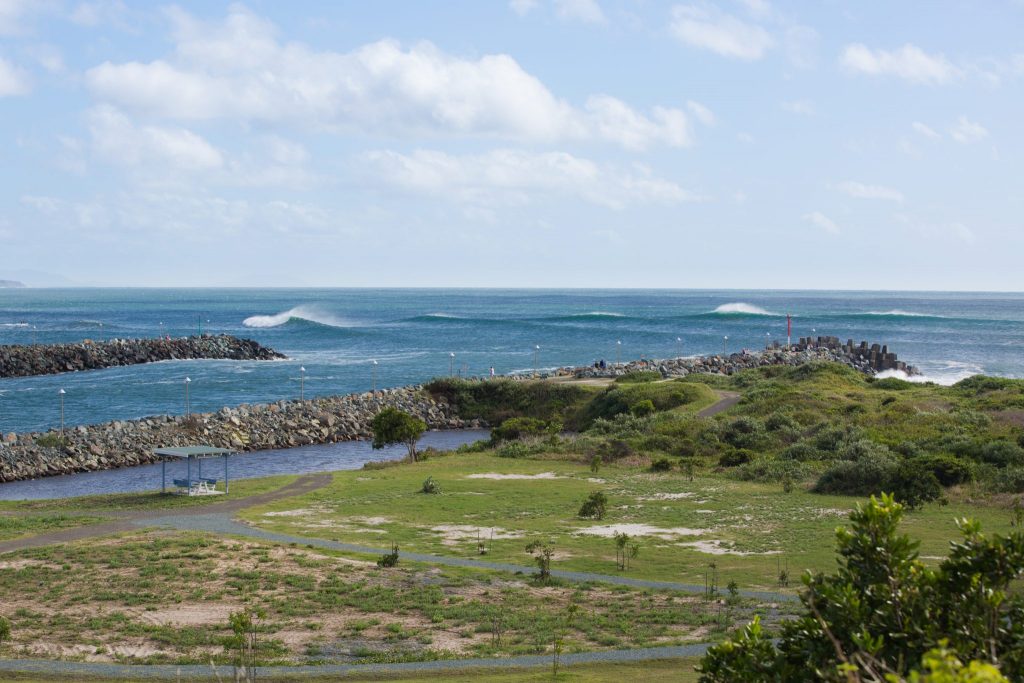
A Protected Species
Around the same time, the scarcity of great whites saw them officially protected under Australian law. At the time nobody imagined the species might make a remarkable recovery in the years ahead… let alone what that recovery might mean for surfers around the Australian coast.
They rode their luck for years…but in recent months their luck has changed.
Tuncurry means “plenty of fish” in Worimi, and a decade-or-so later, there were plenty. For local surfers, sightings of great whites became a regular thing. Small sharks in time became bigger sharks. Guys had close calls. They rode their luck for years… but in recent months their luck has changed.
It depends on who you talk to, but it all started when Col Rowland got hit.
The First Attack
Old Col was surfing Bulls Paddock, the southern end of Seven Mile back in 2016. Clear water, zipping little rights. Early Summer. Sitting on his board he suddenly found himself circled by a frenzied pod of dolphins, worked up about something. The shark hit hard from underneath, blowing his board to pieces and launching Col into the air. With the tail of the board stuck in its mouth – and Col still attached to it by his legrope – the shark dragged him under twice, thrashing wildly. Col kicked furiously to get to the surface, and by blind luck kicked the shark in the snout, scaring it off. Col escaped with a shredded foot, but the psychological lacerations were deeper. The attack ruined him. You don’t see him much in the surf these days.

“Yeah, for me Col getting hit was the point when it just became the new normal,” says Andrew Hills, a local surfer and fisho who’s in the water more than anyone in town. “Something changed. When you spend so much time in one place, to see it changing so radically in that short a time, it’s just crazy.”
The change was white sharks. Plenty of ‘em.
The New Locals
They were there seasonally, mostly around the time of the mullet and whale runs between April and October, but then they’d also show up out of season like they had with Col. Surfers around town started seeing them in the water, cruising past, chasing fish. Small sharks mainly. Juveniles between six and eight feet. They started appearing in Wallis Lake, cruising between the breakwalls and hanging around the fish cleaning tables. Hillsy hooked one while fishing for jewies on Tuncurry Beach. Then the drones went up and people got a rude shock.
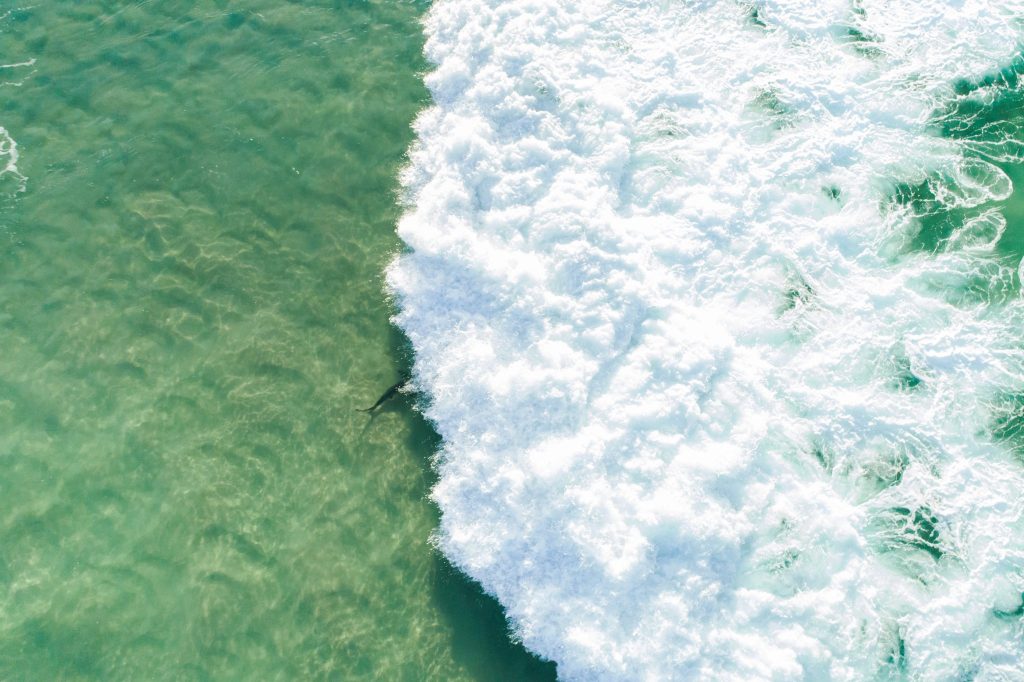
Three hours from Sydney and an hour-and-a-half from Newcastle, Forster-Tuncurry is far enough away for locals to often be surfing alone mid-week. That’s the magic of the place. Champagne water, miles of sand, still a few secret corners. But local dawn patrollers were now quietly looking for someone to surf with.
“When we were younger, we’d never see white pointers,” says local surfing legend Danny Godwin, now in his sixties. “We didn’t worry about sharks ever, even out The Bar, you know. All my surfing years in town I can remember just one occasion where there was a shark out The Bar. One in 40 years. They just weren’t around, and if they were they stayed away from us, you know? The generations before us sorted them out and they had a fear of humans. These ones didn’t.” Surfers began to see patterns. “The big ones were travelling up with the whales, but they’d sort of stay out at sea,” says Danny. “They might come in closer around Boomerang and past the Hawke, but they never came into town. On the way back though they’d come in close.”
Ballina and Byron Shark Attacks
Tuncurry wasn’t an island. A few hours up the coast, things in Ballina and Byron were worse. They were experiencing a bad run of white attacks; two of them fatal. There was a big shift happening, but few answers as to what was driving it.
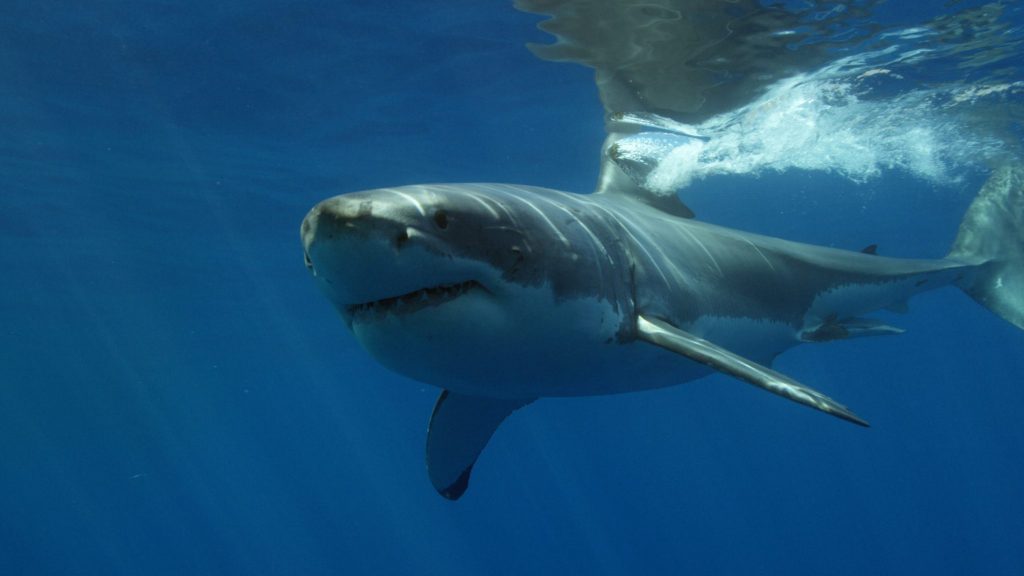
Locals learned Tuncurry was just north of a great white nursery down in Stockton Bight. Wallis Lake – which runs out into the ocean at Tuncurry – was the first major system flushing into the sea as the young sharks headed north. Other factors were playing a part. The horizon was now a highway for humpbacks, while inshore fisheries were rebounding. The Pinnacle fishing grounds off Cape Hawke, some of the richest on the coast were declared a marine reserve to protect a grey nurse population. The local commercial fishing fleet, like most up and down the coast, had dwindled. Everyone had a theory on why they were hanging around town but for the most part, the white shark still remained a mystery.
Solving the Shark Mystery
The scientists rolled into town in 2017. Working for the NSW Department of Primary Industries, in the wake of the Ballina attacks they’d begun trialling new hardware to keep surfers and sharks apart. The most effective of these was the Smart drumline. It would hook a hungry shark, at which point the scientists would head out, tag it, then release it out at sea, alive. It was a win-win-win. It pulled a hungry shark out of the line-up. That shark, once tagged, would set off “pingers” – a series of electronic listening stations up and down the coast – which warned surfers on a phone app that a shark was in the area.
The mystery started to unravel.
For the scientists, they were now able to see where the sharks went. Some went to Kalbarri. Some went to the Chatham Islands. They burned laps of the east coast. It was illuminating. The mystery started to unravel.

The drumlines worked. In just six months they picked up 65 whites off the town beaches, all juveniles, all released alive. Locals would watch the DPI boat head in and head straight back out again. Meanwhile the shark pinger off Forster’s Main Beach became the state’s second busiest. Thousands of hits. It went off so much it stopped acting as a warning device. People just ignored it. “I was down One Mile this day,” recalls Hillsy, “and I watched this old mate strip down to his budgies and swim out around a baited drumline. Couldn’t fucking believe it.”
Sharks Are The New Dolphins
A false sense of security developed. One local surfer recalls – to his amazement at the time – watching a white shark swim through a pack of surfers at North One Mile and the surfers all look at each other and decide not to bother paddling in. Small shark, who cares? They’d seen them a dozen times before.
“We’ve got this beautiful pod of dolphins that swims into the lake every afternoon and swims out to sea every morning,” says Danny Godwin, “and the sharks were now there waiting for them.”
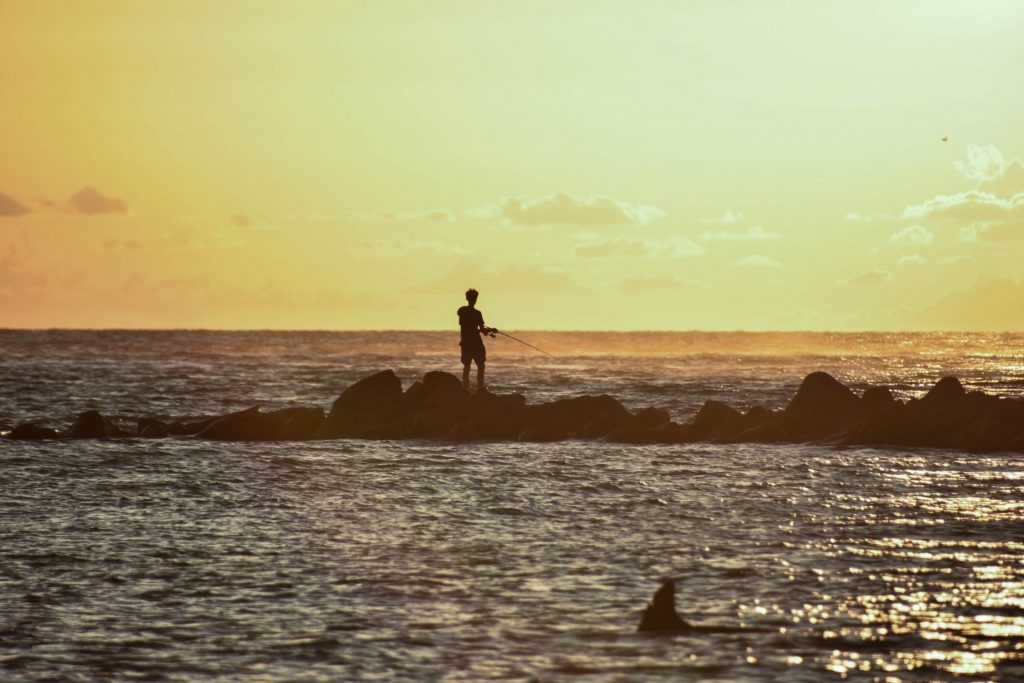
“Coexisting” became a buzzword. Sharks became the new dolphin.
While the balance in the ocean was changing, so too were attitudes on shore. A strong shark conservation movement had sprung up, particularly around whites. With sharks being wiped out in other parts of the world, whites in Australia were becoming a totem species. Old values were being swept aside. Old measures like shark nets were being challenged. “Coexisting” became a buzzword. Sharks became the new dolphin. And the dolphins? “We’ve got this beautiful pod of dolphins that swims into the lake every afternoon and swims out to sea every morning,” says Danny Godwin, “and the sharks were now there waiting for them.”
Questioning the Official Line
The change of attitude extended to the NSW Shark Program. Charged with keeping people safe, they balanced this directive with keeping the white shark safe. The dissonance ran deep. Frontline measures never really developed from the trial, instead replaced with drones and marketing. They were reluctant to get between sharks and surfers.
Perhaps more telling though was the official line, repeated publicly at every opportunity, that there was no scientific proof the East Coast white shark population had grown. The refusal to even acknowledge the possibility that white shark numbers had increased had locals half bemused, half incensed. Were these guys not seeing what they were seeing?
Close calls got even closer.
When the trial ended and the DPI announced their new Shark Program last year, Lennox and Ballina got smart drumlines, Tuncurry got nothing. The sharkiest town on the east coast was left with no frontline defence. The surfers and sharks were left to sort it out between themselves in what Hillsy describes as, “an uneasy relationship.”
Another Close Call
Close calls got even closer. “It was dawn at Elim, along Seven Mile,” recalls Hillsy of an incident earlier this year. “It was pumping and no one around. I don’t have a problem surfing by myself normally, but I’ve got a six-month-old daughter now and my wife made me promise that shit had to stop, which is fair enough.
Here’s this shark, a pretty big white, arm’s length away just checking me out.
So, I put my wetsuit on and sat on the beach and waited for someone to show. The clock was ticking, then a guy I know finally came down and the two of us paddled out together. We paddled across the gutter no sweat and felt okay on the back bank because it was quite shallow, and the water was crystal clear. We surfed for an hour, no dramas, sun had come up and two other guys have paddled out. I was furthest out and just sitting there looking out to sea for a wave and suddenly there it was. It had just come out of the sunrise and was sitting right next to me. Holy shit. Here’s this shark, a pretty big white, arm’s length away just checking me out. It just sat there. If it had wanted me, it could have just taken me, but you could sense this one was curious, looking at me like, ‘What the fuck are you?’ I sat up on my board and waited for it to turn slightly towards North Boomerang and once it did that, me and the other guys spun around and got a wave to shore.”
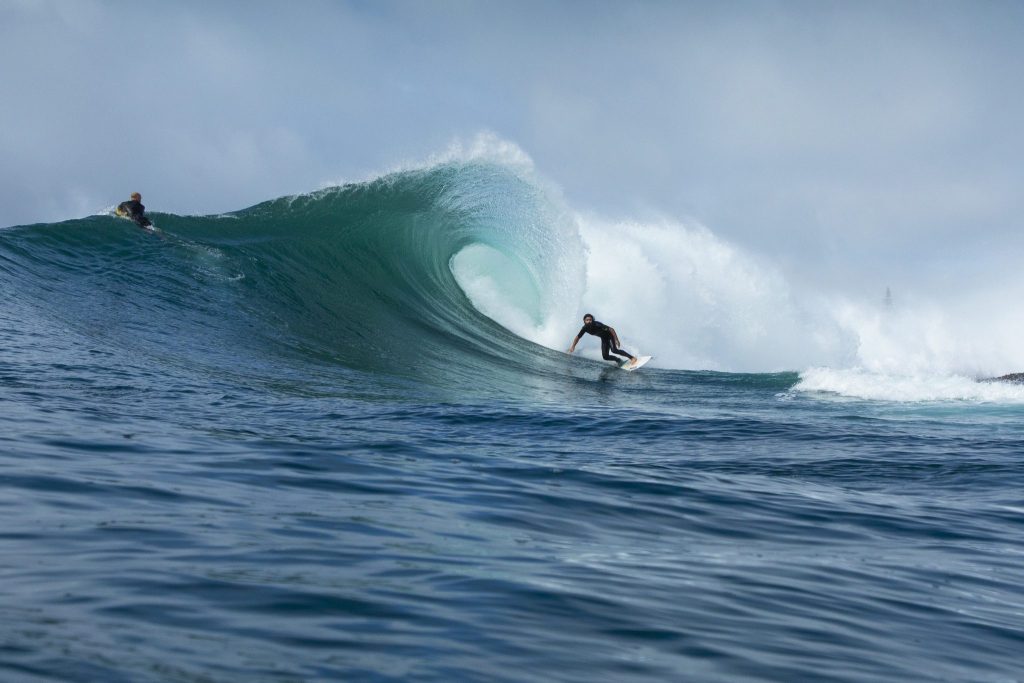
Hillsy has had three encounters in a year, all on Seven Mile. This one wasn’t even the gnarliest. A few years back Surfing World published George Greenough’s shark diaries and Hillsy has kept what George said in the back of his mind. Don’t take your eyes off it. Face it. Don’t turn and run, all its food runs. Hillsy has become pretty good at reading shark behaviour and knows when to worry and when not to. He’s got footage of a white shark cruising along the rocks just 50m from his wife, surfing down the beach.
“But it’s a bee’s dick between an incident and an attack,” he offers. “That’s what I keep thinking. Who knows what flicks that switch?”
Tuncurry Fatality
The text messages started just after 11am.
It was a Tuesday morning, May 19 earlier this year and news that someone had been hit by a shark at Tuncurry had everyone in town thinking the same thing. “That’s the thing that goes through your mind,” said local bodyboarder Josh Kirkman, “that it’s got to be one of your mates.”
When I heard the news, I’d immediately started firing off texts. I grew up in Forster and shared the same anxiety at the news. One of the messages was to my brother, Tim who’s living back in town. He replied that it was a guy from out of town, and that he’d been killed. He then matter-of-factly mentioned that he’d been surfing Tuncurry at the time and had dragged the guy in and tried to save his life.
Mark Sanguinetti, 59 had been on a road trip up from Sydney with some of his mates, chasing surf. Tuncurry was only two-foot and breaking close to shore. Clean water, sunny. Mark had actually spotted the shark and warned everyone, before heading for shore. The shark hit him and wouldn’t let go. My brother and Mark’s mates tried to get to him but couldn’t. The shark was aggressive. By the time the shark let go and they got him to shore, he was gone. Mark didn’t stand a chance. The injuries were horrific.
Before the attack it was a place of only joy and happiness and all of my best memories. Now someone had died there.
For the town, a reckoning had arrived. “We always knew they were there,” said Josh. “It’s not a surprise that someone’s finally been attacked. I think everyone was just a bit complacent or maybe naïve it wasn’t going to happen.” The mood in the town changed in a heartbeat. Josh went back down to Tuncurry Beach the following morning. “I didn’t take a board or anything. I just… I knew that I needed to go and see the place again. Before the attack it was a place of only joy and happiness and all of my best memories. Now someone had died there.” He went for a swim, sat on the beach, and cried.
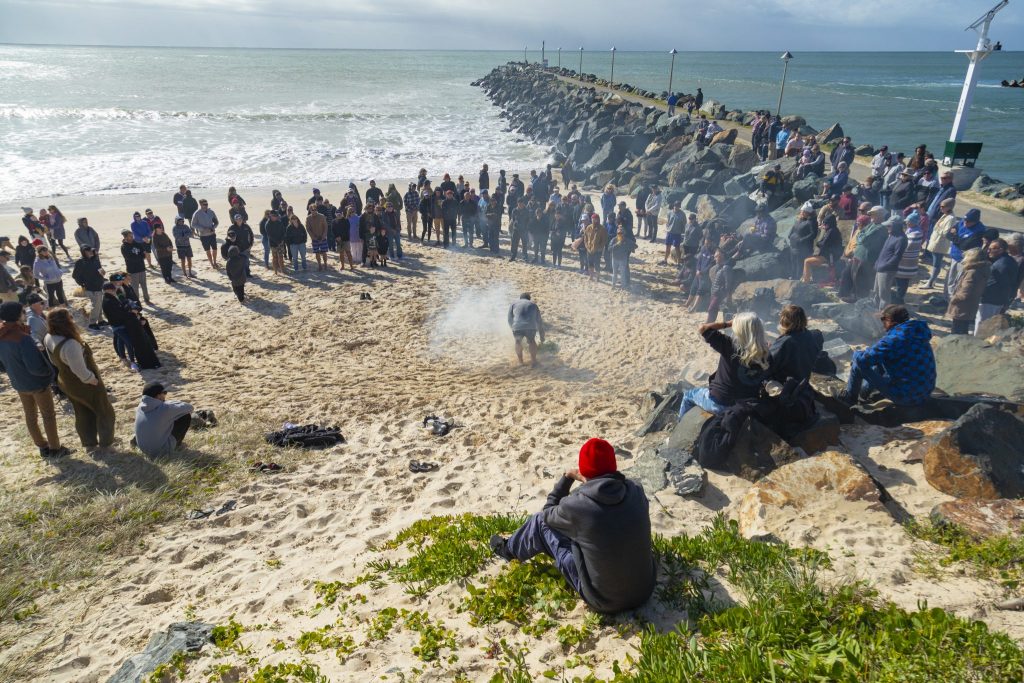
The locals organised a memorial for Mark on the Saturday morning. It was as much to remember Mark, as it was to remember the Tuncurry they once knew. “Tuncurry is sacred to us guys who grew up surfing it,” says local surfer Ben Godwin. “It’s the jewel in the crown and it’s a pretty shocking thing to happen to something so close to the boys’ hearts.” Benny surfed Tuncurry on the morning of the memorial, but not until another six guys had paddled out. “Safety in numbers.”
Getting Back In the Water
The healing would take time, but for my brother and Mark’s mates, they might never quite shake it. My brother – “Chook” to everyone in town – is a fireman and has seen some shit but this came out of a bright blue sky. “It’s one of those things you can’t unsee or unfeel,” is how he put it. He was off work for weeks and saw a psych, but still found himself driving around town, missing the turn-off to home. He and Mark’s mates have kept in touch and helped each other work through it, but Chook’s only just got back in the water, three months later. “It’s gotten better with time,” he says, “but it’s always going to be there in some form or another.”
“It’s one of those things you can’t unsee or unfeel.
For the rest of the town, they had to get back in the water. “I surf Tuncurry a lot, so I didn’t want that head noise,” says Hillsy. “The attack happened on a Tuesday, and I surfed there on the Saturday. But how’s this… the following day we surfed Middle Bank at One Mile, just around the corner. Three-foot A-frames, crystal clear water, really fun with just a couple of mates. My wife surfs and was on the beach with the baby, and she waved me in so she could have a surf. Anyway, we’ve looked out and I’ve gone, ‘Did you see that, Caro?’ She went, ‘Yeah, I did.” The next wave stood up and sure enough there’s a small white about two metres away from our mate.”
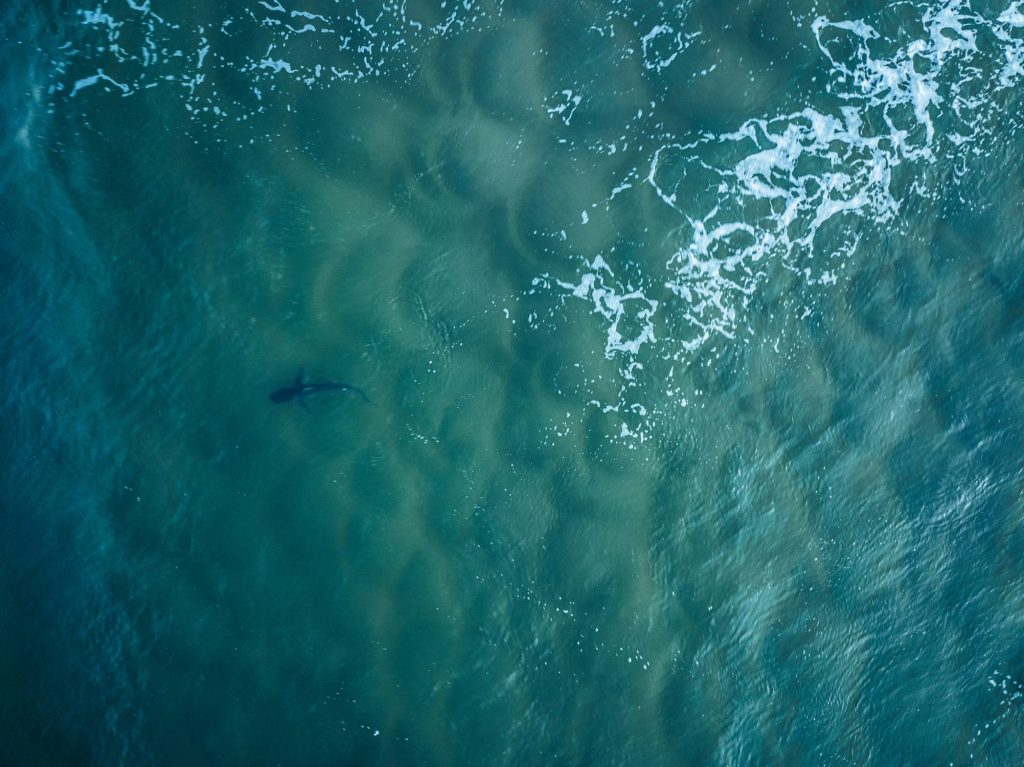
After the attack, Hillsy went back to the Dorsal app and started counting the consecutive days with a tagged shark off Tuncurry. “I stopped counting at 70. And I think you’d be a fool to think it was just one or two tagged sharks swimming around that listening station. So, if that’s only the tagged ones, how many are actually out there?”
Why aren’t they telling us what they’re finding out there?
The DPI turned up the day of the attack and put the drumlines back out. They caught six whites straight up in a day. They were all juveniles, none of them were the shark responsible, but it was clear the place at that point was crawling with whites. The DPI hosted a town hall meeting that week, but the focus was more on the mental health of locals. They didn’t actually talk that much about sharks, or what they were planning to do about them.
“It baffles me,” said Chook, who reached out and has been talking to the DPI. “The analogy to me as a fireman is bushfire. You know the risk is there, but you work to prevent them happening and to minimise their impact. We have building codes, warning systems, hazard reduction burns. Can you imagine if the fire service just turned up the week after a fatal bushfire, held a meeting and told everyone they had more chance of dying in a car accident?”
Locals Left High and Dry
The DPI left town and haven’t been back. As we go to print, the only defence Tuncurry has against shark attack is a clubbie drone that flies over summer school holidays, when the white sharks have moved on. The locals feel like they’ve been left to deal with this on their own. They feel the DPI pulling back is political. They feel shark attacks are only going to increase, and if the DPI engage fully with the problem, every attack lands back on them. But locals are realists. “No one expects a silver bullet that’s going to solve it,” says Hillsy, “and people are rational enough to accept responsibility for themselves going in the water. But when you’ve got technology that works like Smart drumlines sitting in sheds, and you’ve got all this research that needs to be done… why aren’t they out there doing it? Why aren’t they telling us what they’re finding out there?”
Ideologies Clashing
Whereas the attacks five years ago in Ballina created a social chasm between Ballina (let’s go fishing) and Byron (save the shark), the response in Tuncurry was a little more measured. “Sad more than anything,” is how Danny Godwin puts the mood of the town. “Sad because this was avoidable. They’ve known that there’s a problem and no one’s done anything about it. That’s what pissed me off. Giving them pet names – ‘Bruce has been hanging around for months.’ No one wants to wipe them out. They’re incredible creatures, I admire them, but how many do you need? And what price a human life?”
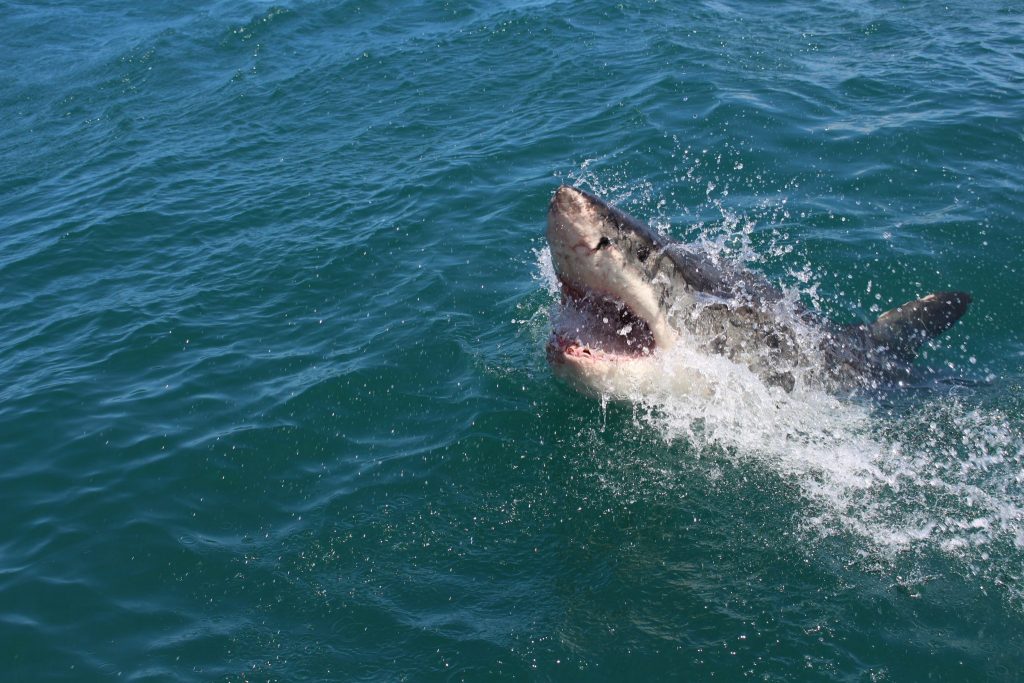
Danny’s son, Ben sees things a little differently. “Yeah, we’ve clashed a little bit over it. Dad thinks there needs to be something done, I feel completely different. This is nature. None of this is ours. Killing sharks comes from the place of ego and control. This is just reinforcing to me whose domain it is, and the other thing is that while surfing is fun, there’s a hardcore element to it. Sharks are just part of that.”
All his life he’s sat wide, waiting and waiting for the best waves. That’s a dangerous thing to do these days.
While they might differ on what needs to be done, Ben can see the anxiety it’s created for his old boy and most everyone else in the town. “He’s quite troubled by it and I think that’s because of his style of surfing. All his life he’s sat wide, waiting and waiting for the best waves. That’s a dangerous thing to do these days. Today I see my father out there, quite worried. He’s not surfing as much. He’s also worried about me going to surf Tuncurry. ‘Mate, just be careful,’ he says.”
What if the next attack is a kid?
Like Danny being worried for Ben, fathers worried for sons and daughters is a common theme in town right now. What if the next attack is a kid? It’s a dark thought. The town is full of young families with surfing kids. That’s why they live here. The week after the attack, Forster Boardriders was called off, and then called off again the following month. Half the club is under 14 and the club has scrambled to see where they stand. A lot of kids haven’t surfed since. A lot of old guys haven’t surfed since. Then there’s the cumulative anxiety of worrying about it every time someone surfs. Worrying in the water. Worrying at home. The sharks have thrown a long shadow over the town.
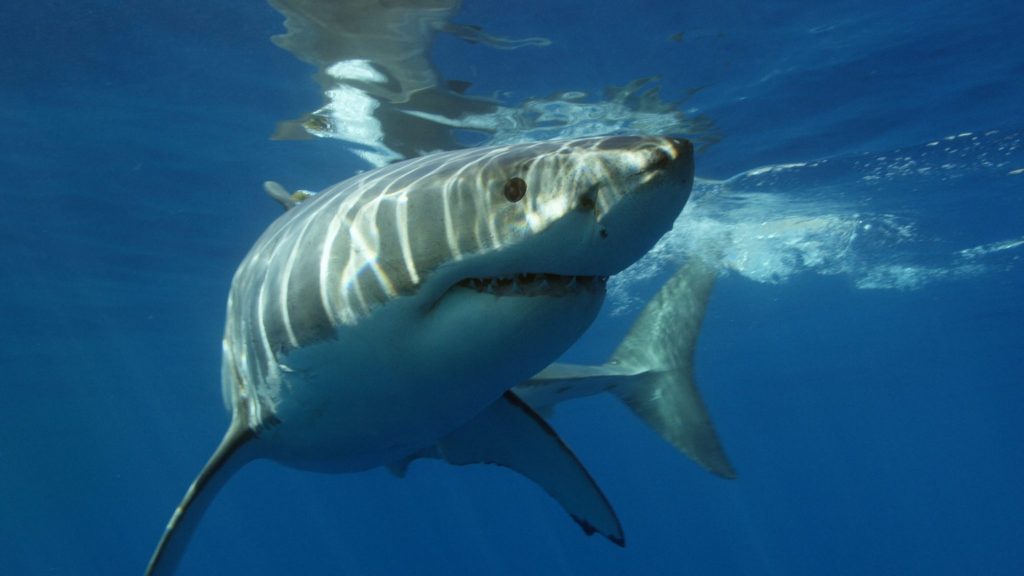
A few weeks after the attack, a southern right whale swum into Wallis Lake. For three days, traffic over the bridge crawled to a stop as people slowed to watch the creature do laps. The whale had an escort from the water police and National Parks. The NSW Environment Minister chimed in to warn people to stay clear, threatening fines. Local surfers, with just a hint of cynicism, joked the whale was better protected than they were.
A Very Local Tragedy
When Mark Sanguinetti died back in May, some Tuncurry locals would later reflect with a sense of guilt that their first response had been, “Is it a local?” They didn’t lose one of their own that day, but in September news of a fatal attack up the coast at Emerald Beach was followed by news that the victim was Tim Thompson, who’d grown up in Tuncurry and whose family own the Tuncurry Post Office.
Plenty of Fish was first published in Surfing World 415 in August 2021. In September 2021 the NSW Department of Primary Industries announced a record $21.4 million investment in shark mitigation measures along the NSW coastline. This included 15 Smart drumlines in the Forster-Tuncurry area.




